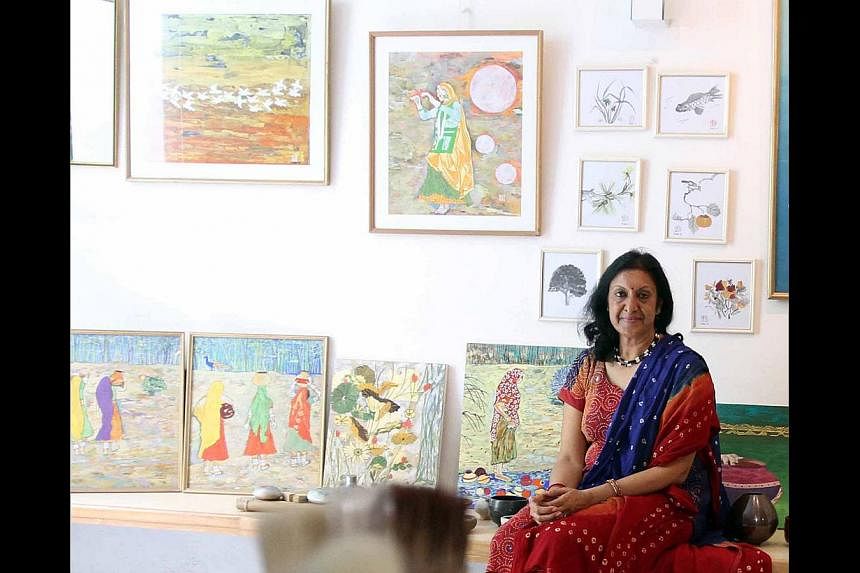Drawing on her global travels, particularly the time she spent in Japan and Singapore (1980-1984) as a diplomat's wife, Indian artist Madhu Jain uses the Nihonga technique while drawing on Indian imagery.
Her second solo with Singapore's Galerie Belvedere travels here from Tokyo. She had exhibited with it earlier in 2002.
Titled The World Around Me, it features 50 works with prices ranging from $500 for a small work in Sumi-e techniques to $9,500 for a triptych in Nihonga.
Jain's creative attempts to project Indian cultural heritage and traditions using Japanese techniques have been hailed as a unique experiment to bridge different cultural traditions while at the same time creating new forms of artistic expression.
In an e-mail interview, the 67-year-old New Delhi-based artist says: "When I first saw Nihonga paintings, I was dazzled. I had never ever seen such technical brilliance and serene environs. They had a suave seduction to which I was completely taken to. I decided to study and research this medium."
She started learning it during the four years she lived in Japan, while her husband was posted as Minister in the Embassy of India in Tokyo from 1994 to 1997. She recalls it being tough as the teachers and artists did not speak English and she had to learn Japanese.
One of the key things she learnt while studying the form was not to crowd her paintings with too many subjects.
"The Sumi-e technique taught me how lines and spaces lend focus to the main subject and how by leaving empty spaces, one could leave much to the imagination," she says.
Sumi-e, single-stroke black-ink painting, is much like the Zen concept conveying minimalism, focusing only on the essence. It is beauty condensed and distilled, the artist adds.
The Nihonga palette has about 1,500 mineral pigments, which are layered with brush, using glue (nikawa) and water on handmade washi paper, with each layer drying in between.
This art form originated in India centuries ago and travelled to the Far East, where, in Japan, it was perfected and given the name of Nihonga.
She brings these aesthetics to her recent works such as Kites and a triptych titled Autumn Reflection.
In Kites, she depicts her home state of Rajasthan, which is known for its vibrancy and colours.
The challenge here was to present without packing the canvas with too much. What went in was as important as what was left out.
"What I wanted to showcase was how blissfully unaware the simple village folks are of the urban tensions and how they go about their work in a relaxed and easy manner."
To do that, she has portrayed women in their bright coloured heavily gathered lehengas (skirts) with their heads covered with long cotton material called dupattas.
In Rajasthan, a desert state, the women in villages generally carry pots filled with water back to their homes.
This painting is set during the annual Kite Festival in mid-January, when the skies are full of kites of different shapes and sizes.
The triptych Autumn Reflection is quite a contrast to this. During the autumn months around August and September, leaves starting changing colours and, in a quick period, go from yellow to orange to brown.
"I was drawn to nature's incredible splash of colours. This painting took me back to Japan. Even though I had experienced it many years ago, I could never forget how awestruck I was when I saw the hills of Japan during autumn.
"The picture kept coming back years later and I was inspired to create this piece, to paint nature in all its glory."
While her medium is Japanese, the style she has developed over the years is all her own.
"Japan taught me that beauty lay in nature alone. It is my love for the environment and nature that attracted me to this eco-friendly medium. I like that it involves the use of natural rock pigments which are derived from minerals, shells, corals, semiprecious stones like garnets and pearls and even gold and silver applied by brush using glue and water on handmade paper."
She adds that since this technique is not known to contemporary artists outside Japan, it has turned out to be "an exciting aesthetic challenge for me".
"I have used this technique to create my own style and expression. The use of different gradations of rock pigments bring out the vivaciousness of the rural folks. There are times when the effect I am after appears lost in the layers and I am often thrilled to see what suddenly emerges boldly once the pigments dry up."
The artist, who has two sons in their 40s, calls her art a reflection of herself.
"They are simple, warm, colourful and cheerful and I think they need very little explanation."
Galerie Belvedere's managing director Jaya Mohideen says she has been wanting to bring Jain's art back after their successful show in 2002. Her works are in several private and corporate collections in Singapore, including CapitaLand's.
Says Mrs Mohideen: "Madhu's art is unique in that she has internalised and distilled the influences of Japanese art and culture, where painting is taken to a delicate and refined platform, and used these techniques to reflect the vibrant culture and scenery of her homeland.
"The results are quite spectacular."

